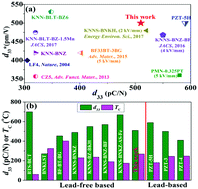Improved piezoelectricity in ternary potassium–sodium niobate lead-free ceramics with large strain
Abstract
Although potassium–sodium niobate (KNN)-based ceramics with good piezoelectric performance have been obtained by a phase engineering strategy, a low electric field-induced strain (<0.2%) even when applying large electric fields is observed in the ceramics prepared by normal sintering, which hardly satisfies practical application demands. Here, a ternary lead-free material system of (0.965 − x)K0.5Na0.5Nb0.975Sb0.25O3–0.035Bi0.5Na0.5ZrO3–xBiFeO3 (KNNS–BNZ–xBF, 0 ≤ x ≤ 0.008) ceramics with excellent overall performance has been designed, aiming to achieve balanced development between piezoelectric and strain properties. A systematic study of the phase structure, electric properties and temperature stability is carried out on the ceramics, and the optimal electric properties (e.g., d33 ≈ 511 pC N−1, Suni ≈ 0.202%, d33* ≈ 505 pm V−1, and Tc ≈ 269 °C) are obtained at x = 0.007 owing to the large tetragonality and R–T phase structure with low polarization anisotropy as well as weak energy barriers. Moreover, a new approach used to evaluate coercivity (Ec) qualitatively provides more choices to identify Ec in ferroelectrics. We believe that it may promote the application of lead-free piezoelectric materials.



 Please wait while we load your content...
Please wait while we load your content...